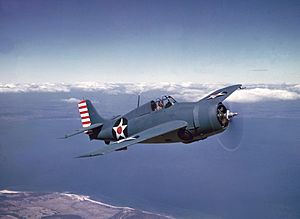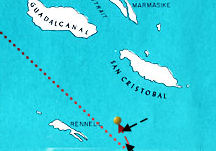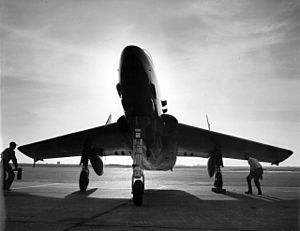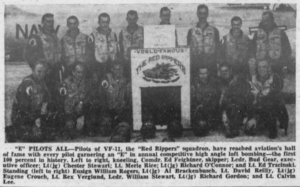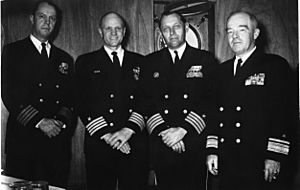Edward L. Feightner facts for kids
Quick facts for kids
Edward L. Feightner
|
|
|---|---|

Feightner in 1970
|
|
| Birth name | Edward Lewis Feightner |
| Nickname(s) | Whitey |
| Born | October 14, 1919 Lima, Ohio, U.S. |
| Died | April 1, 2020 (aged 100) Coeur d'Alene, Idaho, U.S. |
| Allegiance | |
| Service/ |
|
| Years of service | 1941–1974 |
| Rank | |
| Commands held | USS Okinawa (LPH-3) USS Chikaskia (AO-54) Air Group 10 VF-11 |
| Battles/wars | World War II Cold War |
| Awards | Legion of Merit (2) Distinguished Flying Cross (4) Air Medal (12) Navy Commendation Medal Congressional Gold Medal |
| Other work | Aerospace Industry |
Rear Admiral Edward Lewis Feightner (October 14, 1919 – April 1, 2020) was a brave United States Navy officer and pilot. He fought in many important battles during World War II in the Pacific Ocean. During his two combat tours, he shot down nine enemy airplanes, which made him a "flying ace".
After the war, he became an early member of the famous Blue Angels flight team, flying the lead solo plane. He was also a test pilot, trying out new aircraft and electronic systems. He even helped develop ways for small fighter jets to carry special weapons. Feightner led several air units and training groups that helped the Navy switch from propeller planes to jet aircraft. He commanded two Navy ships and played a big part in designing jet planes that are still used today.
Feightner was the only pilot to successfully land a special version of the Vought F7U Cutlass jet on an aircraft carrier. He also led his squadron, VF-11, to win a special "E" award for excellence, the first time every pilot in an Atlantic fleet unit achieved this in one exercise. After leaving the Navy, Feightner continued to promote aviation and share his amazing experiences with others.
Contents
Early Life and Learning to Fly
Edward Feightner was born on October 14, 1919, in Lima, Ohio. He grew up in this small town. He went to the University of Findlay in Findlay, Ohio. While in college, he learned to fly through a government program called the Civilian Pilot Training Program (CPTP). This program helped train many civilian pilots, creating a group of skilled flyers who could join the military if needed. By 1940, Feightner had earned his private pilot license. He finished college in 1941.
World War II Heroics
As World War II drew closer, Feightner really wanted to fly for his country. He tried to join the United States Army Air Corps, but there was a long waiting list. When he found out the Navy would accept him right away, he decided to become a naval aviator. On June 16, 1941, Feightner joined the United States Navy Reserve. He then entered the Naval Aviation Cadet Training Program.
He completed his flight training at Naval Air Station Corpus Christi, Texas, on April 3, 1942. This earned him his commission as an ensign and made him a naval aviator. After more training, he was assigned to a squadron called VF-5. However, their ship, the USS Yorktown (CV-5), was sunk by the Japanese at the Battle of Midway before he could join. Feightner was then sent to VF-3 in Hawaii. His commanding officer there was Edward O'Hare, a famous Navy fighter ace. O'Hare gave Feightner the nickname "Whitey" because he couldn't get a tan, even after spending hours in the sun.
Joining the Grim Reapers
In October 1942, Feightner joined VF-10, known as the Grim Reapers. They flew the Grumman F4F Wildcat from the aircraft carrier USS Enterprise (CV-6). The leader of VF-10 was James H. Flatley, whom Feightner greatly admired.
On October 16, 1942, Enterprise sailed from Pearl Harbor to the South Pacific. Less than ten days later, Feightner made his first night landing on an aircraft carrier. This happened after his group got lost and returned after dark. On October 26, 1942, during the Battle of the Santa Cruz Islands, Feightner shot down his first enemy plane. It was a Japanese Aichi D3A dive bomber attacking Enterprise. He also likely shot down another plane. For his actions that day, Feightner received an Air Medal.
After repairs, Enterprise went to fight a Japanese fleet threatening the Solomon Islands. On November 14, 1942, Feightner protected U.S. bombers and attacked enemy ships during the Naval Battle of Guadalcanal. These attacks destroyed seven Japanese troop ships. After the battle, VF-10 stayed on Guadalcanal to help the Marines. Life on the island was tough and dangerous, but Feightner only stayed for less than a week before returning to Enterprise.
On January 30, 1943, during the Battle of Rennell Island, Feightner shot down three Japanese Mitsubishi G4M "Betty" torpedo bombers in one fight. These bombers were attacking the USS Chicago (CA-29), a heavy cruiser. VF-10 destroyed six of the bombers before they could reach the cruiser. However, the remaining planes launched their torpedoes, sinking Chicago quickly. Feightner, whose engine had been slow to start, arrived just in time to shoot down three more "Bettys." For his bravery that day, Feightner received the Distinguished Flying Cross and another Air Medal. He ended his first combat tour with four confirmed enemy planes shot down.
Flying the Hellcat
In May 1943, Feightner was assigned to VF-8, where he began flying the new Grumman F6F Hellcat. This squadron was based at Naval Auxiliary Air Station Pungo and led by Lt Cdr William M. Collins Jr., who also became a nine-victory ace. VF-8 was assigned to the new carrier USS Intrepid (CV-11). Feightner helped test the F6F by performing the first takeoffs and landings on the Intrepid during its trials.
In March 1944, Feightner's squadron began operations from USS Bunker Hill (CV-17). This carrier was part of the Fast Carrier Task Force TF 58. Bunker Hill attacked Japanese positions across the Pacific. VF-8 saw its first combat during a two-day attack on Palau. On March 30, 1944, Feightner became a flying ace when he shot down a Japanese Mitsubishi A6M "Zeke" over Peleliu island. This battle was also the first time pilots used a special 'Z-suit' (G-suit) that helped them handle the forces of sharp turns without losing consciousness.
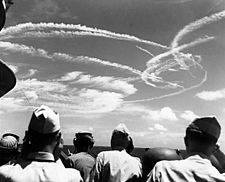
As U.S. forces moved closer to Japan, Feightner took part in attacks on Yap and Woleai to cut off Japanese forces there. At the end of April, the task force returned to Truk. On April 29, 1944, Feightner shot down another "Zeke" over Truk, bringing his total to six enemy planes destroyed.
In June 1944, the U.S. began the Mariana and Palau Islands campaign. Feightner flew during the Battle of the Philippine Sea, which American pilots called the 'Great Marianas Turkey Shoot' because so many Japanese planes were shot down. He fought in many battles over the next few months, including those over Saipan, Guam, Okinawa, and Tinian.
As U.S. forces pushed towards the Philippines, Task Force 38 moved to weaken Japanese air power on Formosa (now Taiwan). During the Aerial Battle of Taiwan–Okinawa on October 12, 1944, Feightner shot down three more "Zekes," bringing his total to nine enemy planes destroyed. Feightner continued flying missions with VF-8 until Bunker Hill returned to the U.S. for repairs in November 1944.
Training New Pilots
After returning to the United States in November 1944, Feightner became a fighter instructor. He taught new pilots at NAS Los Alamitos in California and later at Naval Air Facility (NAF) Thermal. Near the end of World War II in 1945, Feightner was a gunnery officer for VF-21 at NAS San Diego.
Feightner's Air Victories
The table below shows the planes Feightner shot down during World War II. He was credited with 9 planes destroyed and 4 probable kills.
| Date | Number | Type of Plane | Battle/Location | Aircraft Flown | Unit |
|---|---|---|---|---|---|
| October 26, 1942 | 1 | D3A "Val" | Battle of the Santa Cruz Islands | F4F Wildcat | VF-10 |
| January 30, 1943 | 3 | G4M "Betty" | Battle of Rennell Island | F4F Wildcat | VF-10 |
| March 30, 1944 | 1 | A6M "Zeke" | Raid on Peleliu | F6F Hellcat | VF-8 |
| April 29, 1944 | 1 | A6M "Zeke" | Raid on Truk | F6F Hellcat | VF-8 |
| October 12, 1944 | 3 | A6M "Zeke" | Aerial Battle of Taiwan–Okinawa | F6F Hellcat | VF-8 |
| 9 |
Life After the War
Becoming a Test Pilot
After the war, Feightner attended the U.S. Navy Test Pilot School in Maryland. He graduated in July 1949 and became a test pilot. He flew many different aircraft, from helicopters to large transport planes. He also tested famous planes like the Grumman F8F Bearcat and the Vought F4U Corsair. When the famous pilot Charles Lindbergh came to evaluate a plane called the Tigercat, Feightner was the one who taught him about it.
Feightner was chosen as the Navy's main test pilot for the Vought F7U Cutlass. This was a new jet fighter-bomber with swept wings and a unique tailless design. From July to August 1951, he tested how well the Cutlass could land and take off from aircraft carriers like the USS Midway. Feightner had several close calls in the Cutlass. Once, an engine exploded and caught fire during takeoff. He managed to land the burning plane safely. On July 23, 1951, he made the first (and only) carrier takeoff and landing of a specific Cutlass version on the USS Midway. Landing the Cutlass was tricky because the pilot couldn't see the deck well. Even though the Cutlass had problems, Feightner was a skilled pilot who handled it.
Flying with the Blue Angels
In January 1952, Feightner joined the U.S. Navy's famous flight demonstration team, the Blue Angels. The team was told to include the Cutlass in their shows, even though Feightner and the Blue Angels commander, "Butch" Voris, thought the plane wasn't ready for close formation flying. The Cutlass was one of the Navy's first jets with a hydraulic flight control system, and it wasn't very reliable.
Because of these issues, the Cutlasses had to fly separately from the rest of the team. This led to the "diamond" and "solo" roles that the Blue Angels still use today. Feightner recruited another former Blue Angel, Harding C. "Mac" Macknight, to fly the second Cutlass. At the start of the 1952 show season, the team's other jets had fuel problems, so the Cutlasses performed the main show for several months. During one show, Feightner's plane lost all hydraulic power during takeoff. He managed to keep control and land safely, clipping trees but thrilling the crowd. Feightner and Macknight performed amazing maneuvers that showed off the Cutlass's speed and power.
However, more problems and near-fatal accidents eventually stopped the Blue Angels from using the Cutlass. During one trip, both Cutlasses had engine problems. Feightner's engine failed, and then Macknight's engines caught fire. Macknight bravely landed his burning plane. Feightner was redirected to land at a new runway in Chicago, which was still under construction. He was told to ignore obstacles and land anyway. Because of this, Feightner's Cutlass became the first plane to land on the new runway for what is now O'Hare International Airport. After another emergency landing, the Cutlasses were retired from the Blue Angels.
Back to Testing New Systems
In September 1952, Feightner returned to flight testing. He worked on developing new systems and tactics for fighter aircraft. He tested how to best use these systems in combat.
On December 3, 1953, Feightner took part in the first public demonstration of the steam catapult. This new system was designed to launch heavy jet aircraft from carriers. Feightner flew a propeller plane for the test and said the steam launch was "much better for the pilot" because it was smoother.
Feightner also helped develop ways to deliver weapons from the McDonnell F2H Banshee jet. He worked on tests that included the longest non-stop, round-trip flight from a carrier, covering over 2,800 miles.
Leading Aviation Units
Commanding the Red Rippers
In January 1955, Feightner took command of VF-11, also known as The Red Rippers. They flew the McDonnell F2H-4 Banshee. He led VF-11 to win top honors in a special bombing competition in 1956. All fourteen pilots in VF-11 received the Navy's Battle Effectiveness Award for their amazing accuracy with this difficult technique. This made VF-11 the first Atlantic fleet unit where every pilot earned an "E" (for excellent) in the same exercise.
In August 1956, VF-11 deployed to the Mediterranean on the USS Coral Sea (CV-43). During the Suez Crisis a few months later, the carrier prepared for battle and to evacuate American citizens, creating a tense situation.
In March 1957, Feightner was put in charge of the Jet Transitional Training Unit (JTTU) in Kansas. This unit trained pilots who flew propeller planes to fly jets and gave refresher training to aviators returning to sea duty.
Leading Air Groups and Design
In February 1959, Feightner became the commander of Carrier Air Group Ten (CVG-10) on the USS Forrestal (CV-59) in the Mediterranean. He continued this role on the USS Essex (CV-9) for another tour. From February to July 1960, Feightner helped write some of the first manuals for Naval Air Training and Operating Procedures Standardization (NATOPS). These manuals aimed to reduce Navy aircraft accidents. In July 1960, he went to the Naval War College to study military tactics and strategy. He graduated in 1961.
In July 1961, Feightner became the project officer for the F4H-1 Phantom II and later for a new fighter project that became the F-111 Aardvark. A year later, he was chosen to lead Navy Fighter Design. In this role, he helped develop planes like the Vought F-8 Crusader, North American FJ-4 Fury, and the Northrop Grumman E-2 Hawkeye. The Hawkeye, as of 2015[update], is still used by the U.S. Navy today. From August 1963 to November 1964, Feightner served as the operations officer for the Commander of Carrier Division Two aboard the USS Enterprise.
Becoming a Senior Leader
From 1964 to 1967, Feightner commanded two U.S. Navy ships. First, he was captain of the fleet oiler USS Chikaskia (AO-54). This ship provided fuel to the fleet in the Mediterranean and set a record for how fast it could start pumping fuel. After learning about amphibious operations, Feightner commanded the amphibious assault ship USS Okinawa (LPH-3) during a tour in the Caribbean in 1966. Under Feightner's command, Okinawa received an award for Aviation Safety. In 1967, he brought Okinawa to Naval Base San Diego, where it joined the U.S. Pacific Fleet.
In 1967, Feightner was assigned to the office of the Deputy Chief of Naval Operations (CNO) for Air at the Pentagon. He was responsible for overseeing and coordinating air warfare programs. Between 1969 and 1970, he also directed the Naval Aviation Weapons Systems Analysis Group. In June 1970, Feightner was promoted to the two-star rank of rear admiral.
In September 1970, Feightner served his final tour with the Naval Air Systems Command (NAVAIR). He participated in studies that led to the development of the Grumman F-14 Tomcat and McDonnell Douglas F/A-18 Hornet jets. He also helped ensure that new aircraft designs were put into production and supported throughout their operational life. After 33 years of service, Feightner retired from active duty on June 30, 1974.
Later Years and Legacy
Even after retiring from the Navy, Feightner remained very involved in aviation. He shared his flight experiences at many events:
- A Conversation with Whitey Feightner—A speech at the National Air and Space Museum in 2007, where he talked about his Navy career.
- Memoirs from an Aviator's Logbook—Another speech at the National Air and Space Museum in 2011, where he shared stories as a fighter pilot, early Blue Angel, and Navy test pilot.
- 100 years of U.S. Naval Aviation—A discussion in 2011 where Feightner and other experts talked about the past, present, and future of naval aviation.
- 70th anniversary of Victory in Europe (V-E) Day—Feightner participated in a special flyover at the United States Capitol on May 8, 2015, celebrating the 70th anniversary of the end of World War II in Europe. He flew as a passenger in one of the old airplanes.
Feightner also helped lead groups like the American Fighter Aces Association and the Golden Eagles, which honors early naval aviators. In 2017, he received a handmade quilt from the Quilts of Valor organization, honoring his service to the country.
Edward Feightner passed away on April 1, 2020, at the age of 100, in Coeur d'Alene, Idaho. He was buried in Arlington National Cemetery in October 2021.
Awards and Decorations
Feightner received many awards for his military service:
 |
|||
| Badge | United States Naval Aviator | |||||||||||
|---|---|---|---|---|---|---|---|---|---|---|---|---|
| 1st Row | Legion of Merit with one gold award star | Distinguished Flying Cross with three gold stars |
||||||||||
| 2nd Row | Air Medal with two silver and one gold star | Navy and Marine Corps Commendation Medal | Combat Action Ribbon | |||||||||
| 3rd Row | Navy Presidential Unit Citation with three service stars | China Service Medal | American Defense Service Medal | |||||||||
| 4th Row | American Campaign Medal | Asiatic-Pacific Campaign Medal with eleven campaign stars | World War II Victory Medal | |||||||||
| 5th Row | Navy Occupation Service Medal | National Defense Service Medal with one bronze star | Philippine Liberation Medal with one bronze star | |||||||||
Other Honors and Recognitions
On October 7, 1998, Feightner was honored by being inducted into the Carrier Aviation Test Pilot Hall of Fame. He is also an Honorary Fellow of the Society of Experimental Test Pilots. For his work with the International Midway Memorial Foundation, Feightner was made an honorary member of the United States Naval Academy (USNA) class of 1942. In 2013, he was recognized as a distinguished alumnus of the University of Findlay. On May 20, 2015, Speaker of the United States House of Representatives John Boehner presented the Congressional Gold Medal to Feightner and 37 other fighter aces.
See also
- Awards and decorations of the United States military
- List of inactive United States Navy aircraft squadrons
- List of United States Navy aircraft squadrons
- List of United States Navy aircraft wings
- List of World War II aces from the United States
- World War II Allied names for Japanese aircraft


